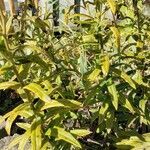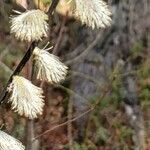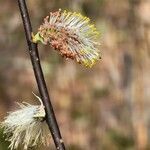Shrubs, 0.3-3 m, (forming clones by layering). Stems: branches dark red-brown, not or weakly glaucous, tomentose to glabrescent; branchlets red-brown, yellow-brown, or greenish brown, moderately to very densely villous, tomentose, or velvety-tomentose to glabrescent. Leaves: stipules absent or rudimentary on early ones, absent, rudimentary or foliaceous on late ones, apex acute; petiole convex to flat, or shallowly grooved adaxially, 0.5-7(-12) mm, velvety, pilose, or villous adaxially; largest medial blade (sometimes hemiamphistomatous), narrowly oblong, narrowly elliptic, elliptic, oblanceolate, obovate, or broadly obovate, (13-)20-90(-135) × 3-23(-35) mm, 2.3-9 times as long as wide, base cuneate or convex, margins revolute or flat, entire, crenate, or sinuate, (glands submarginal), apex acuminate or convex, abaxial surface glaucous, sparsely to densely tomentose or woolly, hairs erect or spreading, wavy, adaxial slightly or highly glossy, glabrous, pubescent, tomentose, or pilose; proximal blade margins entire or serrulate; juvenile blade green, densely tomentose to glabrescent abaxially, hairs white, sometimes also ferruginous. Catkins flowering before leaves emerge; staminate 6.5-34 × 5-19 mm, flowering branchlet 0-1 mm; pistillate (and staminate) moderately to very densely flowered, stout, subglobose, or globose, 9-47(-55 in fruit) × 5.5-19 mm, flowering branchlet 0-4 mm; floral bract brown, black, or bicolor, 0.8-2 mm, apex rounded or acute, abaxially moderately densely hairy, hairs (white), straight or wavy. Staminate flowers: adaxial nectary oblong or square, 0.2-0.7 mm; filaments distinct, glabrous or hairy basally; anthers purple turning yellow, ellipsoid or cylindrical, 0.4-0.6 mm. Pistillate flowers: adaxial nectary square, 0.4-0.8 mm, shorter than stipe; stipe 1-2.5 mm; ovary obclavate or pyriform, moderately densely to sparsely short-silky-villous (hairs refractive), beak slightly bulged below styles, (valves recurving in fruit); ovules 6-12 per ovary; styles (sometimes slightly distinct distally), 0.2-0.4 mm; stigmas slenderly to broadly cylindrical, 0.2-0.56 mm. Capsules 5-12 mm.
More
Colonial shrub 1–3 m; twigs flexible, yellowish to brown, velutinous-tomentose, or eventually glabrate; stipules lanceolate, often deciduous; lvs oblanceolate to narrowly obovate, 3–10(–15) × 1–2(–3) cm, acute or abruptly short-acuminate, somewhat revolute-margined, entire or sparingly undulate-crenate, dark green (and often puberulent) above, glaucous, somewhat rugose, and ± gray-tomentose beneath (sometimes also with some reddish hairs), becoming glabrate; petioles 3–7 mm; catkins precocious, sessile or subsessile, often recurved, the staminate 1–2 cm, the pistillate 1.5–4 cm at maturity; scales 1.5–2 mm, blackish, long-villous; stamens 2; frs narrowly lanceolate-rostrate, 6–10 mm, gray-hairy; pedicels 1–2 mm; style 0.2–0.4 mm; 2n=38, 76. Scattered but common in open woods, dry barrens, and mesic or wet prairies; Nf. and s. Que. to N.D., s. to Fla. and Tex.
Dry mixed woods and forests, wet to dry prairies, grassy balds, loess bluffs, sandy stream terraces, coastal barrens, Carex-Typha meadows, on fine sand to rocky granitic, gneissic, limestone, and serpentine substrates; at elevations to 1,600 metres.



